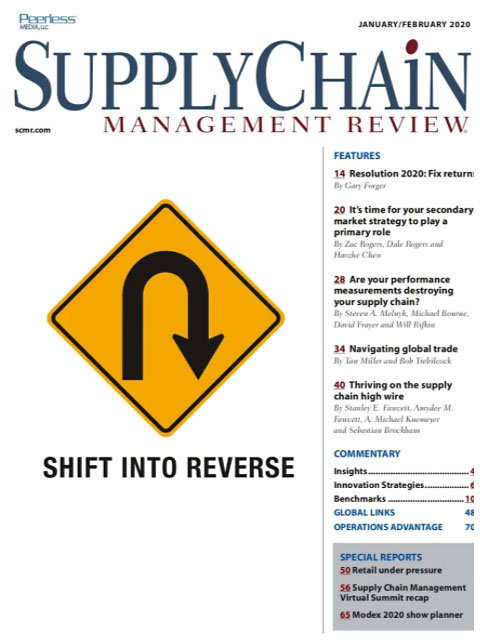Sorry, but your login has failed. Please recheck your login information and resubmit. If your subscription has expired, renew here.
January-February 2020
If the holidays at your household were like most, the gifts were chosen and wrapped with care, and then half were returned in the week after Christmas. Maybe more than half. After all, who among us hasn’t bought four shirts in a variety of sizes and colors with the intent of keeping one and returning three. And why not: Retailers and e-tailers alike have made returns seamless, easy and cheap. At least for the shopper. For the supply chains of the retailer, manufacturer or brand owner, returns are a once-neglected area that is growing into a major focus of supply chain managers who don’t want to see their organizations lose their shirt taking… Browse this issue archive.Need Help? Contact customer service 847-559-7581 More options
Innovative companies are leading in the transformation of the traditional supply chain to an enterprise supply network (ESN).* The innovators and early adopters of this way of thinking have learned that the supply chain is not a chain at all. Rather it is an ecosystem of suppliers and customers. The change can be seen in how some companies refer to the supply chain function. Take Procter & Gamble for example. They dropped the supply chain management business model more than a decade ago for a product supply model that breaks down much of silo management and focuses the organization on demand driven flowpaths. More recently, the term supply network is used to complement product supply as P&G thinks more about ecosystem management.
A connected ecosystem emerges
The ESN model leverages digitalization to connect all of the participants in the Core ESN as well as connecting to enabling and supporting network participants. Operating as a connected community of commerce, companies will operate as a market ecosystem business model. As this concept matures, ecosystem commerce will leverage business 4.0 technologies to enable ecosystem commerce platforms (ECP) that optimize purpose-driven, ethical and responsive market networks to efficiently manage variability in ecosystem material flowpaths from source to consumption to sustainability in a circular economy that creates value for all participants in the ecosystem globally (see Figure 1).
To achieve ecosystem commerce, companies will embark on a journey that actually starts with a digital twin foundation that will progress through five stages of digital business 4.0 maturity (see Figure 2).

This complete article is available to subscribers only.
Log in now for full access or start your PLUS+ subscription for instant access.
SC
MR
Sorry, but your login has failed. Please recheck your login information and resubmit. If your subscription has expired, renew here.
January-February 2020
If the holidays at your household were like most, the gifts were chosen and wrapped with care, and then half were returned in the week after Christmas. Maybe more than half. After all, who among us hasn’t bought… Browse this issue archive. Access your online digital edition. Download a PDF file of the January-February 2020 issue.Innovative companies are leading in the transformation of the traditional supply chain to an enterprise supply network (ESN).* The innovators and early adopters of this way of thinking have learned that the supply chain is not a chain at all. Rather it is an ecosystem of suppliers and customers. The change can be seen in how some companies refer to the supply chain function. Take Procter & Gamble for example. They dropped the supply chain management business model more than a decade ago for a product supply model that breaks down much of silo management and focuses the organization on demand driven flowpaths. More recently, the term supply network is used to complement product supply as P&G thinks more about ecosystem management.
A connected ecosystem emerges
The ESN model leverages digitalization to connect all of the participants in the Core ESN as well as connecting to enabling and supporting network participants. Operating as a connected community of commerce, companies will operate as a market ecosystem business model. As this concept matures, ecosystem commerce will leverage business 4.0 technologies to enable ecosystem commerce platforms (ECP) that optimize purpose-driven, ethical and responsive market networks to efficiently manage variability in ecosystem material flowpaths from source to consumption to sustainability in a circular economy that creates value for all participants in the ecosystem globally (see Figure 1).
To achieve ecosystem commerce, companies will embark on a journey that actually starts with a digital twin foundation that will progress through five stages of digital business 4.0 maturity (see Figure 2).
SC
MR


Latest Supply Chain News
- How CPG brands can deliver on supplier diversity promises
- How S&OP provides the answer to in-demand products
- AI, virtual reality is bringing experiential learning into the modern age
- Humanoid robots’ place in an intralogistics smart robot strategy
- Tips for CIOs to overcome technology talent acquisition troubles
- More News
Latest Podcast

 Explore
Explore
Software & Technology News
- AI, virtual reality is bringing experiential learning into the modern age
- Humanoid robots’ place in an intralogistics smart robot strategy
- Tips for CIOs to overcome technology talent acquisition troubles
- Game on: Rethinking change management for the digital era
- Predicting stockouts: Enhancing FMCG resilience through data-driven insights
- Top Performers Investing in, Benefitting from AI
- More Software & Technology
Latest Software & Technology Resources

Subscribe

Supply Chain Management Review delivers the best industry content.

Editors’ Picks






